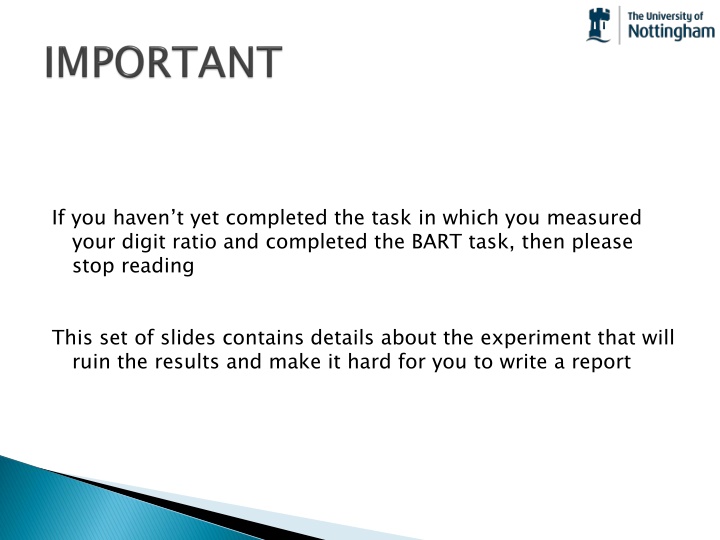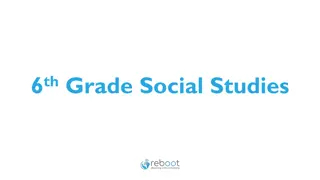Effects of Experimenter Bias on Risk-Taking Behaviors
This experiment explores the impact of demand characteristics and experimenter bias on subjects' responses, rather than solely focusing on testosterone levels. By manipulating subjects' beliefs about their digit ratios and testosterone levels, the study sheds light on how demand characteristics can influence risk-taking behaviors and participant responses in research settings.
Download Presentation

Please find below an Image/Link to download the presentation.
The content on the website is provided AS IS for your information and personal use only. It may not be sold, licensed, or shared on other websites without obtaining consent from the author.If you encounter any issues during the download, it is possible that the publisher has removed the file from their server.
You are allowed to download the files provided on this website for personal or commercial use, subject to the condition that they are used lawfully. All files are the property of their respective owners.
The content on the website is provided AS IS for your information and personal use only. It may not be sold, licensed, or shared on other websites without obtaining consent from the author.
E N D
Presentation Transcript
If you havent yet completed the task in which you measured your digit ratio and completed the BART task, then please stop reading This set of slides contains details about the experiment that will ruin the results and make it hard for you to write a report
Measuring you risk-taking behaviour with the BART is a simple matter of measuring the average number of pumps you performed on the (non- bursting) balloons In excel you need to create a column of data showing the number of pumps for each balloon, filtered by whether or not the balloon burst The average of this column of filtered data is your BART measure of risk taking (higher scores mean higher willingness to risk popping the balloon)
Youve been led to believe that you were studying the effects of testosterone on risk-taking behaviours That isn t exactly true (although it might be interesting too) In reality today s study is about the effects of experimenter bias and demand characteristics on subject s responses Demand characteristics are a problem when subjects know the aim of the study being conducted. There s a strong tendency for subjects to try to conform to what they think the experimenter wants (their demands )
How would you go about measuring such effects? You could give people an expectation that they will be faster/slower/better in condition A than condition B, and then measure their behaviour But what if people genuinely are faster/slower/better in A than B? (the effect of demand characteristics are confounded with an actual change) What you really need to do is give different groups different demand characteristics and measure the difference between the groups
We created two different expectations about the results in the two groups. Both groups were told that their digit ratios were quite high (we lied about the mean digit ratio being 0.85 most of you will have a higher DR than that) Group A were told that this implies a low testosterone level and a tendency to low-risk behaviours Group B were told that this implies a high testosterone level and a tendency to high-risk behaviours That is the only thing that differed between the groups (the experiment you ran was actually identical)
By measuring your digit ratio and knowing this theory about its effects, you (hopefully) had some idea of what was expected of you. Did that effect your behaviour in the risk measurement? Let s explore some possible outcomes
When told that your (supposedly high) DR predicts high/low BART scores, did you become more/less risky? We could test for a difference between the groups in their BART scores When told that a high DR implied high testosterone and, therefore more masculine traits, did it bias your measurement of your own DR? We could look test whether there was a difference in average DR between groups NB if some people consider themselves more masculine and others consider themselves more feminine, the bias effect might average to be zero?
We could also look at the data for both groups (with their different expectations) and see if there really is an effect of digit ratio We could plot the data from both groups in a clustered X-Y scatter plot (with colours specifying different groups). Do the data have similar patterns between groups?
Analysing the data for each individual is relatively easy: Open your data file and filter out the balloons that were popped (the number of pumps for those tell us more about the balloons than about your behaviour!) (Insert the formula =IF(J2=0,G2, down) =IF(J2=0,G2, ) ) and then drag
then take the average of number of pumps for these un-popped balloons: This average is your risk- taking score (more pumps means happier to take risks). Now we need to compare the risk-taking scores across subjects for the two groups
By now the demonstrators should have entered your group data into an SPSS data file for you to download Based on your lecture in SPSS (stats Week 7?) conduct a t-tests comparing; mean digit ratio between the groups mean BART score between the groups Do either show significant differences? To plot the overall relationships between DR and BART; select >Chart>ChartBuilder (see following slides)
Drag variables to appropriate locations, then click OK
Double-click the graph in the OUTPUT window to edit it and add lines
Once you have opened chart in the Chart Editor, click here to add lines of best fit, then close the editor
As before, get frequency of males and females with >Analyze>DescriptiveStatistics>Frequencies As before, get info about age range with >Analyze>DescriptiveStatistics>Descriptives
In this study the PsychoPy experiment is rather complex, with many Code Components to determine the size throughout the trial don t worry about trying to understand all that now! But you should be able to see from the Excel spreadsheet that every balloon had a different breakPoint (the size at which it would burst), varying from 0.1 (tiny) to 2.0 (the full size of the screen) [Why does a size of 2.0 mean the whole screen? In the default units in PsychoPy the screen coordinates range from (-1,-1) bottom left to (+1,+1) for top right. A size of 2.0 will go from -1 to +1. Simple!] In this study the size (in these normalised units) at each point in time was calculated as: 0.1 + (nPumps x 0.015)
In reality the average digit ratio for males is around 1.0 and for females is around 0.96 (hence, when we told you that it was 0.90 most of you ended up categorising yourself as high DR) In reality, the theory claims that a huge number of things (including sexuality, health, interests in clothes shopping ) are related to DR But before you take them all very seriously, check each paper for demand characteristics and experimenter bias!























